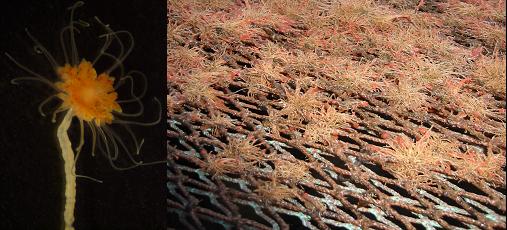|
Biofouling on aquaculture constructions
The main objective is to develop a knowledge-fundament, capacities and solutions on bio-fouling, bio-fouling control, bio-fouling loads and bio-fouling sensors dedicated to net constructions
Background Figure 1. The hydroid Ectopleura larynx on nets. Methods Finally, during field experiments at a commercial salmon farm near Hitra, we investigated the effects of colour and copper on the settlement and growth of biofouling. We also took underwater pictures of the biofouling community on cage nets at different depths (1, 5, 10 and 15 m) and over time (weekly to fortnightly sampling from August to December 2008). These pictures are currently being processed with an image analysis program to calculate the net aperture occlusion. Results and discussion This study also showed for the first time that hydroids maintain their attachment to the nets by three strategies: winding the hydrophyton around the net, growing between loose filaments and threads, and incorporating filaments into their chitinous perisarc. Therefore, current net constructions with multi-filament nylon threads provide a structure for maintaining the attachment of both juvenile and adult E. larynx on the nets and hinder their removal. Finally, the growth experiments in the laboratory demonstrated that E. larynx, whose polyps had been cut off, could re-grow to complete adults within 5 days. Even when E. larynx were cut repeatedly every 2 days for 6 days, they could re-grow. These results suggest that hydroids need to be removed completely during the underwater washing procedure to delay their re-growth on the nets. Future research in 2009 will focus on the effects of (1) nano-structured surfaces on the settlement of E. larynx larvae, (2) fish feed and faeces on the feeding of E. larynx, and (3) the underwater washing procedure on the net structure, coating and biofouling development on cage nets. |
Project leader
Leif Magne Sunde (SFH) Postdoc. Fellow:
Partners
Egersund Net AS International collaboration: |

